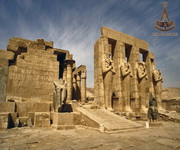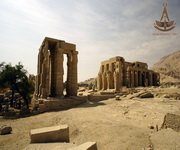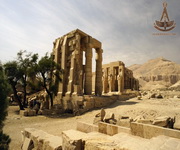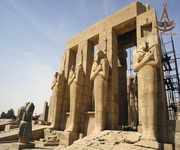 |
 |
 |
|||||||||
- WEST THEBES - "I am Ozymandias, King of Kings. If anyone would know how great am I and where I buried, let him surpass any of my works." Inscription at the feet of the Colossal statue infront of the Entrance to Ramesseum. The Mortuary Temple of King Ramesses II (1290-1279 BC) and the god Amon Ra, known as Ramesseum, is located in Theban Necropolis - the Resting Place of the Ancient Egyptian Kings of the New Kingdom.
Pharaoh of the XIX Dynasty, Ramesses the Great, spent 20 years for building of his grandiose Memorial Temple Complex in Western Thebes during his 67-year reign, at the period ancient Egyptian power and glory in the XIII th century BC. The French scientist Jean-Francois Champollion was the first who determined the true identity of the complex. After studying the Necropolis area, it had appeared that the ruins of the Theban Temple were the architectural masterpiece of the Pharaoh of the XIX Dynasty - Ramses II, or "Ramses the Great." Since that times, this ancient object is named as "Ramesseum", a name given by Champollion in 1829. Hypostyle hall, occupying the major part of the Temple, contains 29 columns, which depicts fragments of scenes of the famous Kadesh battle.
The 1st court has only one colonnade. The second court - two rows of columns, made in the form of statues of Ramses II in the shape of Osiris. To the south of the second court there is a smaller hypostyle hall with eight columns in the form of papyrus. This place is called the Astronomy Hall, where the first 12-month calendar in the history was depicted. In the north-west of Ramesseum there is a complex of royal warehouses, built of mud bricks. They are the earliest arched buildings in history.
These warehouses were used for storing funeral materials, various worker tools, as well as grain storerooms. In ancient Egypt, grain was valued as precious as the gold, and from royal temple vaults it was shipped all over the country. The size of such granaries determined the generosity and wealth of the reigning King. Before the entrance to Ramesseum there was once a majestic statue, depicting the King Ramses II, sitting on the throne. The Colossus statue was carved from red Aswan granite. It's weight was about 1000 tons, and height - 19 meters. If the Colossus was still towering above the ground, it could rival the Colossus of Memnon and the statues of Ramses, carved into the mountains at Abu Simbel. To our great regret, now we can see only some fragments of this ancient masterpiece.
I met a traveller from an antique land who said: Percy Bysshe Shelly, 1817
The origins of modern Egyptology have been traced since the arrival of Napoleon Bonaparte's army to Egypt in summer of 1798. Among the troops of the French Emperor, a significant place was occupied by people of science - those ones, whose works, written under the desert sun of the Sahara, revealed the world their famous 23-volume report, known as the "Description of Egypt" (fr: Description de l'Égypte). The next explorer of Ramesseum was Italian engineer and researcher Giovanni Belzoni. In 1815, upon his arrival to Cairo, he met the British Consul General Henry Salt, who hired him to transport to England a fragment of the statue, found at the entrance to the Ramesseum. This fragment, the so-called "Younger Memnon", was probably located to the right from the entrance to the temple, while Colossus, according to the scheme below, taken from the from Napoleon's report, was located to the left of the entrance.
Due to Belzoni's engineering skills and his hydraulic mechanisms, the 7-ton head of the statue of Ramses II ("The Younger Memnon") has arrived to London in 1818. A few years later it was exhibited in the British Museum.
The first sketch of Ramesseum was made in 1780 by the Danish naval captain and researcher Frederick Lewis Norden, who became famous after the publication of the work "Journey from Egypt to Nubia."
Subsequently, the views of Ramesseum were reflected in the works of Scottish artist David Roberts and a number of first photographers, researchers of Egyptian antiquities.
(Click the image to enlarge)
Photographer: Bechard Henri, 1887 (Click the image to enlarge)
Photographer: Schroeder, 1900 (Click the image to enlarge)
Since 1991, the archaeological and restoration works in Ramesseum is carried out by the joint Franco-Egyptian mission.
ISIDA Project Research Group visited Ramesseum scince 2011 to 2017. Thanks to the ongoing restoration work on the territory of the Temple complex of Ramses II, the magnificent architectural ensemble gradually emerges from the sand, where the ageless stone is carrying through the Time the priceless historical chronicles, set by the great Egyptian King more than 3 thousand years ago. General view of the Temple.
                                Internal architectural structures of the Temple.
Bas-reliefs and statues.
Granite Colossus.
King's granaries, made of mud brick.
© Copyright 2017 of ISIDA Project . All rights reserved. |
|||||||||||
 |
 |
 |